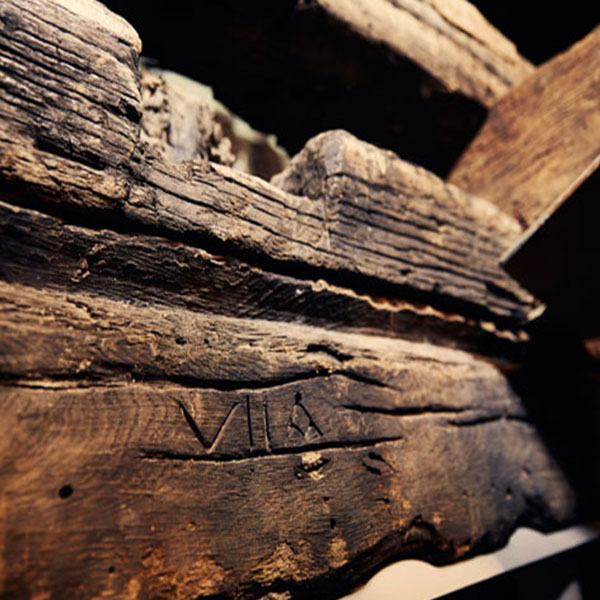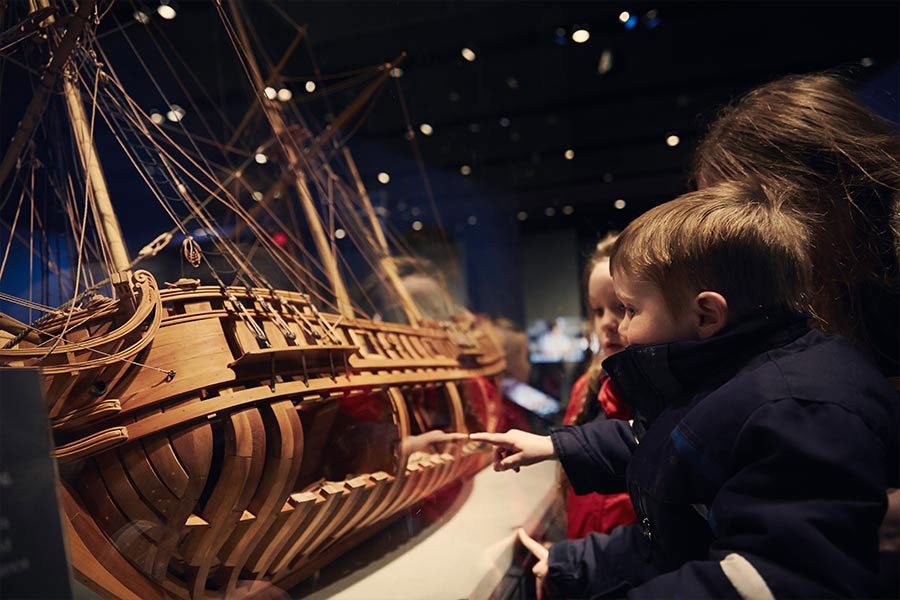Bullock Museum exhibit reveals early Texas history
Important exhibition on European colonization in America opens Oct. 25
OCTOBER 17, 2014 (AUSTIN, TX) — One of the most significant exhibitions on European colonization in the United States will open next week at the Bullock Texas State History Museum. Beginning Oct. 25, 2014, one of French explorer Robert Cavelier, Sieur de La Salle's ships that sank along the Texas coast more than 300 years ago, is set to be reassembled in the museum's gallery and visitors will see a centuries-old international story of cultural conflict unfold.
"La Belle: The Ship That Changed History," brings together for the first time the 17th-century ship timbers, more than 120 of the 1.6 million artifacts excavated with La Salle's ship, newly edited video footage, and a 4D film that tells this important Texas narrative.
"The exhibition of the shipwreck 'La Belle' is the culmination of nearly 20 years of work by dozens of experts in the fields of archaeology, marine conservation, history, and exhibition design," Bullock Museum Director Dr. Victoria Ramirez said. "Very few museums in the world have on view such a vast collection of 17th-century artifacts that tell such a compelling and extraordinary story. The Bullock Texas State History Museum is simply honored to present 'La Belle' to the public."
Through an extraordinary feat of archeology and engineering, the "La Belle" shipwreck was excavated by the Texas Historical commission in the mid-1990s. Dr. James Bruseth was the lead archeologist on the project to excavate one of the most important shipwrecks in North America. He has authored books about the discovery and excavation of "La Belle" and La Salle's ill-fated expedition to establish a colony in the late 1600s.
After 330 years under water, the bottom third of the ship and some of its cargo will be on display at the Bullock Museum in Austin, Texas, with Bruseth as curator.
"'La Belle' is one of the most important shipwrecks ever discovered in North America," Bruseth said. "It will be the centerpiece of a spectacular new display in the heart of the Bullock Museum, placing it among the nation’s most innovative history museums. The new exhibition will offer an unprecedented opportunity to actually reorient the way we educate the public about 17-century regional, national, and world history."
The wreck of "La Belle" in Matagorda Bay and collapse of La Salle's Fort St. Louis colony near Victoria, Texas, changed the course of history — not just for Texas, but for America and the world.
"The clash among the French, the Spanish, and the American Indians helped forge the modern foundation of Texas more than three centuries ago," Bruseth said. "Cultural conflict in 17th-century Texas among these groups was a pivotal turning point, not only for the history of the state, but at national and international levels."
Most Texans – indeed most Americans – are unaware that the first European colony in the eastern part of the state was French, not Spanish. The incursion of France into New Spain represented by La Belle and the colony site of Fort St. Louis triggered a wave of settlement by the Spanish that resulted in the rich Hispanic heritage we have today, he said.
The unique public-private joint venture to excavate, preserve and display "La Belle" is designed to reveal to visitors a little-known chapter in the dramatic early history of the Lone Star State. Artifacts include jewelry, wine bottles, cooking utensils, canons, pole arms and other military items, all of which help tell the story.
"'La Belle' is not only a time capsule of European colonization in the New World, but is also an ongoing case study in how we preserve, understand, and interpret evidence of the past," Bruseth said. "The new exhibition is the result of 19 years of planning and conservation by an international team of museum professionals, archaeologists, and historians."
During the course of the exhibition on view through next spring, "La Belle" will be reassembled by experts in full view of the public. The 800-pound keel and 1,100-pound keelson are the largest portions of what remains of "La Belle." These pieces form the foundation of the preserved bottom third of the ship's hull. When the exhibition opens, Bruseth and Chief Conservator Peter Fix of the Texas A&M University Conservation Research Laboratory, along with museum staff, will rebuild this 600-piece jigsaw puzzle, reassembling the hull, timber by timber as part of the new exhibition.
In conjunction with the exhibition, "Shipwrecked," a new 4D immersive film experience premieres Saturday, October 25, 2014 in the Bullock Museum's Texas Spirit Theater. The film follows the perilous journey of the French explorer La Salle, revealing the personalities and struggles that beset both the voyage and colony as told by a young boy who was one of the few survivors. The 26-minute, age-appropriate film uses 4D effects felt by the audience to create a dynamic experience.
A new catalogue about "La Belle" and its associated artifacts has been published and is available online and in the Bullock Museum Store.
"The 'La Belle' ship is a significant archaeological find, telling an under-told chapter of history," Dr. Ramirez said. "The catalogue includes scholarly essays that provide context to the 17th-century story as well as documents the 20th and 21st century process of excavation, conservation, and exhibition. The film is a fun and engaging complement to the exhibition. We based the story on the journal of Henri Joutel who sailed with La Salle. After 'La Belle' sank, Joutel returned to France where his daily chronicles were published. The journal, on loan from the Boston Public Library, will be featured in the exhibition."
"La Belle: The Ship That Changed Texas History" will be on view daily beginning Oct. 25, 2014 at the Bullock Museum, located at 1800 N. Congress Ave. in Austin, Texas. Museum staff, archeologists and conservators will be in the gallery reconstructing the ship Wednesday through Saturday during regular museum hours. Visit TheStoryofTexas.com/la-belle for more about the exhibition, museum hours, programs, showtimes and membership.
Downloads
The Bullock Texas State History Museum, a division of the State Preservation Board and an accredited institution of the American Alliance of Museums, creates experiences that educate, engage, and encourage a deeper understanding of Texas. With dynamic, award-winning exhibitions that illuminate Texas history, people, and culture, educational programming for all ages, and an IMAX® theater with a screen the size of Texas, the Museum collaborates with more than 700 museums, libraries, archives, organizations, and individuals across the world to bring the Story of Texas to life. For more information, visit www.TheStoryofTexas.com
Media Contact
| General Inquiries | |
|---|---|
| 512-463-5424 | |

